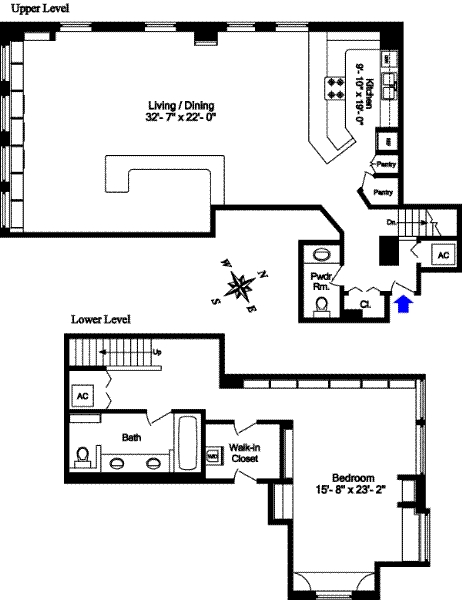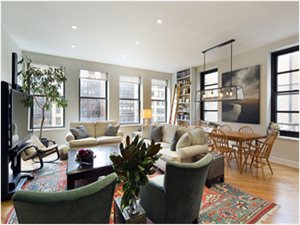calendar + renovation = 100% increase for 22 West 26 Street loft
5 years helps a Manhattan loft, but not as much as this renovation, however
I did a half-off loft this week (March 31, half-off finally sells 620 Broadway artist loft with (obviously) some issues), so it is a bit of karmic payback to hit a loft that doubled in value. The “1,910 sq ft” 2-bedroom + 2 bath duplex loft #7H at 22 West 26 Street was sold on February 27 at $2.59mm by the guy who bought it on February 2, 2010 for $1.215mm. Precise readers will note that is a gain of 113% in 61 months. You already know there was an intervening renovation and you want to know what the StreetEasy Manhattan Condo Index suggests was the change in the overall Manhattan residential market in that time: 36%. So the calendar (which implies a current value in 2010 condition of about $1.647mm) was a much smaller factor in the current value than the renovation.
As usual, I lack actual facts about the renovation budget; as usual, that won’t prevent me from making things up ball parking some renovation estimates to get an idea of how much value was created by (more or less) how many renovation dollars.
it ain’t cheap to move a kitchen, even if only ten feet
The listing has no floor plan, but I am very familiar with this loft so I have a good idea of where the work was done between 2010 and 2015. Here is what the recent seller started with:

count the windows on the upper level, please (there will be a quiz)
Back in the day, this was a rather large One Bed Wonder (i.e., a loft optimized for everyone to sleep in one room, as tagged here and here) with a full bath downstairs and a powder room upstairs, with the only obvious place to add a second bedroom being in the southeast corner of the upper level. If you did that, however, you’d ruin the volume upstairs by stealing half the south windows for that second bedroom.
The main current listing photo shows that’s not what the recent seller did to add a second bedroom (and it shows what a bad idea that would have been):

still 4 large south windows in the living room, right?
The riddle is solved by the (new) kitchen photo:

2 kitchen windows (how many did there used to be?)
The old kitchen was gutted and turned into a (dark, unless they punched a new window) “bedroom”, with the new kitchen on the new wall, about ten feet further south than in 2010. The kitchen array hardly changed, with the gas in the new island and the sink and electric appliances on the new back wall of the kitchen, but it now captures the northernmost west windows on the upper level. Voila!
Truly a new kitchen. The loft was “completely renovated with great attention to detail”, but (with one exception) it doesn’t seem as though there was much other movement. The downstairs full bath has been upgraded (“a gorgeous, large, marble master bath with double sinks and separate tub and shower stall”) and expanded (separate tub and shower), but the real trick was expanding the upstairs powder room into a full bath. I’m told that they cheated acquired a few more feet from the hallway, as there was simply no room in the old floor plan for a full bath there.
Let’s fearlessly ballpark the new relocated kitchen, the upgraded master bath downstairs, and the expanded former powder room upstairs at $250,000, which should be generous for work that has no custom babbling. Another $200,000 for miscellaneous (floor refinishing, the drop ceiling that accommodates high-hat lighting, and …?), with no need to play with the existing 2-zone central air.
While this was a “complete” renovation, it wasn’t a gut. My ballparked $450,000 budget comes to $236/ft, which may strike some as stingy. Bump that to $300/ft and we’re still under $600,000. Now compare that cost to the Index-based increased value from 2010 to 2015: $947,000. On these (reasonable) assumptions, the recent seller created more than $1.58 in value for every $1 in that (ballparked) renovation budget. (My guess is much more, still.)
Nicely played, sir; nicely played. But that wasn’t his best trick, methinks.
Buy Low, Sell High is easier to say than to do
On the original assumptions, the renovation accounted for about $943,000 of the difference in value from 2010 to 2015, with the mere passage of time (as measured by the StreetEasy Index) accounting for (only) about $347,000. Of that renovation premium, more than $343,000 was extra, in the sense of beyond what the seller (likely) paid for the renovation work. In any comparison of Then and Now values, we can never know for a given loft why the observed difference that beats the Index does so. Perhaps, as these ballpark numbers suggest, it was because the renovation was a huge hit (in this case, taking a 1+1.5 loft to a 2+2 loft). Or, perhaps one side of the roundtrip transaction was a market outlier.
I mention this because the recent seller bought in 2010 at $1.215mm, or $636/ft. By February 2010 the overall Manhattan residential real estate market was well into the thaw that followed the nuclear winter that followed the Lehman bankruptcy and ensuing credit crisis in September 2008. I have to wonder if the key factor in the seller’s happy math was the $1.215mm at which he started.
The loft severely underperformed the selling team’s expectations at $1.215mm:
| Feb 27, 2009 | new to market | $1.895mm |
| Mar 16 | $1.75mm | |
| April 9 | $1.595mm | |
| June 16 | $1.499mm | |
| July 1 | change firms (not agents) | |
| Oct 3 | $1.449mm | |
| Nov 4 | contract | |
| Feb 2, 2010 | sold | $1.215mm |
This history is a textbook illustration of the painful phenomenon known as Chasing The Market Down. February 2009 was a horrible time to be a seller, and this seller was clearly at the wrong price at the wrong time. Not just once, but five times, over nine months. When, as mentioned, the overall market was beginning to recover.
So my theory is that the recent seller at $2.59mm benefitted from a below-market purchase in 2010. I understand that the concept of “below market” is facially improbable, if not impossible: every public sale of a loft that has been professionally exposed to The Market is a market sale. But this one looks to me as though it got punished, first for coming out at the wrong time, then for serially picking too-high prices, then for simply being too long on the market and a target for further discounts.
we’ve been here before, but you’d never know it
As I mentioned, I know this loft well. Over the ten years that I was president of the coop board in this building we held many board meetings in this loft. So I knew the 2010 seller well, as well. When I saw this recent sale, I went looking in the Manhattan Loft Guy archives for the first time I blogged about this loft. I was certain I had blogged about it, but couldn’t find it in any search based on the address. That’s pretty frustrating!
It took me a while, and some serious head scratching to find my March 25, 2009, am I a coward? assessing + bearing risk in a risky world. You won’t find an address in that post, but that’s the post I’ve been thinking about. That’s a fun post, written in real time about a dynamic market. Bear with me, and read this paragraph (at least):
I noticed a Manhattan loft recently to market that (a) is a pretty spectacular loft, (b) in a building I am pretty familiar with, (c) in which there is a fairly timely and extensive set of market inputs (i.e., closed sales), (d) that is offered through a very experienced and professional agent, and (e) that is priced well above where I think The Market for that building is in March 2009. I then noticed two other lofts in buildings I am well familiar with, also with fairly timely and extensive sales history, also offered through experienced and professional agents. Yes, also priced well above where I think The Market is today.
Loft #7H in March 2009 was one of those “two other lofts in buildings I am well familiar with, also with fairly timely and extensive sales history, also offered through experienced and professional agents. Yes, also priced well above where I think The Market is today.” (Since I stopped writing about then-current listings in April 2008, this post did not identify the listings I was talking about on March 25, 2009, but [trust me], #7H was one of the referents.)
I knew this coop very well, there was timely and extensive sales history in the building, and #7H was offered by professional and experienced agents (who knew the building as well as I did, in fact). For whatever reason they agreed on that price, the loft then struck me as “priced well above where I think The Market is today”. The thrust of that March 25, 2009 post was that (in the three specific instances I had in mind at that time) I hoped the seller was fully aware of the risks of being over-pried in that particular market.
I may sprain my elbow reaching behind my back, but here’s a key from that post from Nuclear Winter:
To be even more pedantic about it, the law of supply and demand requires that some of these lofts priced above The Market will never sell — not just that they will sell for fewer dollars. The ones that are over-priced today may be nimble enough to catch up to the active market, but they will be competing with an increasing number of new-to-market lofts. Some will simply never catch up.
Again, I assume that the sellers mentioned here have discussed all this with their experienced and professional agents and that the sellers have decided to run the risk that their unique lofts will do better than The Market would indicate generally, because their lofts are better than the general lofts. But if these sellers really want to sell, I assume that they have a plan in mind to adjust their prices if (when) they learn that The Market disagrees.
One more time: “The ones that are over-priced today may be nimble enough to catch up to the active market, but they will be competing with an increasing number of new-to-market lofts.” Look again at the full #7H listing preceding the recent seller’s purchase in February 2010. I wrote that more than six months before #7H finally found a contract, after the first of four price drops, when #7H was still asking 44% more than The Market would eventually yield.
As I said, I suspect that the recent seller did so well on his buy-and-sell, in part, because he bought really low. Now you know why I think that.

Follow Us!